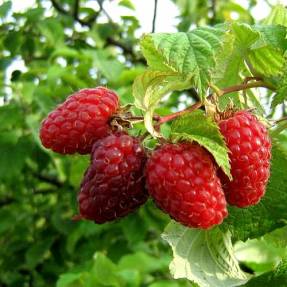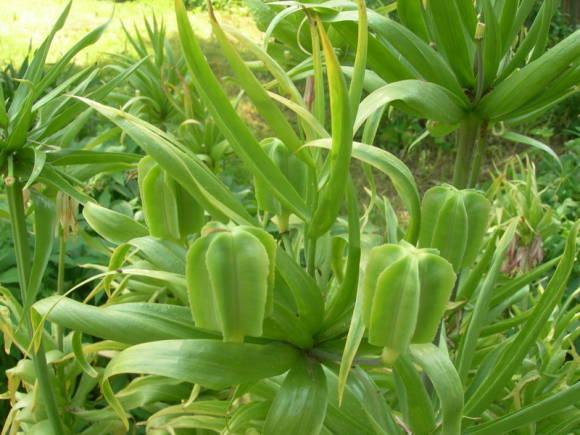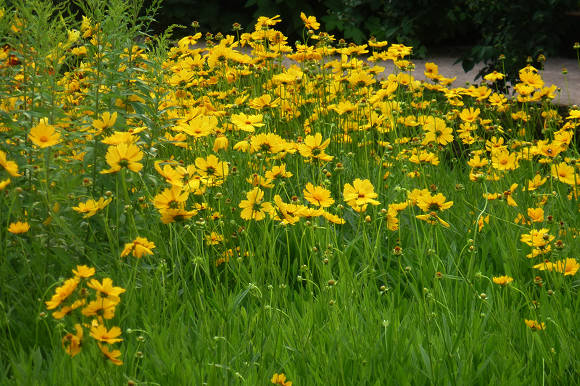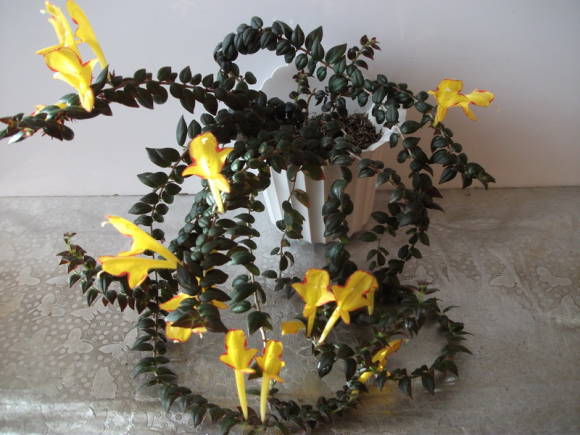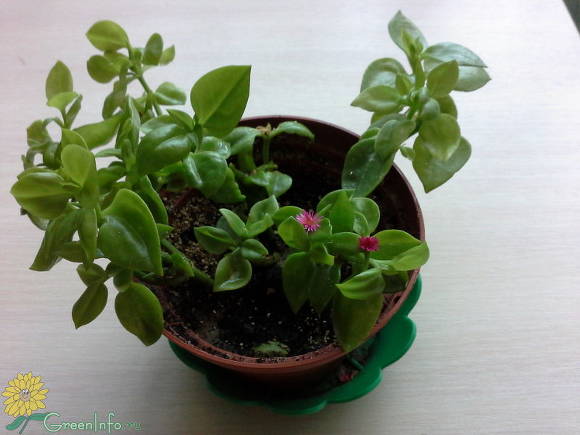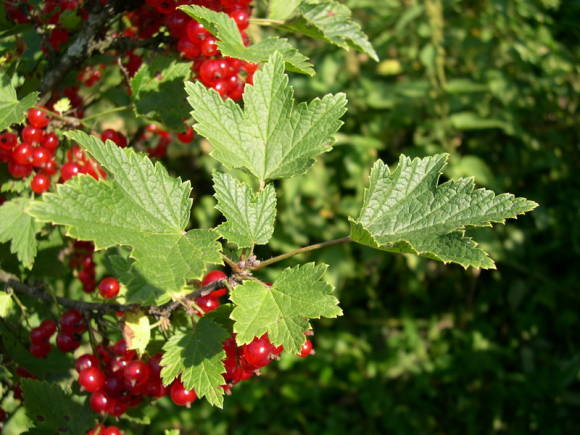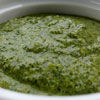
Ficus Benjamin, or brilliant (Ficus benjamina syn. Ficus nitida) - the most popular representative of the numerous genus of ficus, along with rubbery ficus. This is due to its high decorative qualities, simple and inexpensive growing process.
In its native conditions, in the tropics of South Asia and Northern Australia, where it is warm and rather humid all year round, Benjamin's ficus grows into a huge tree more than 30 meters high. Numerous aerial roots extend from its trunk and branches, which become additional support and often form a multi-stemmed banyan tree. Sometimes the trees grow so big that they form intricate sculptures. The roots penetrate into the ground to a depth almost equal to the height of the trunk, therefore, in countries with a tropical climate, it is necessary to protect sidewalks, communications and building foundations from their powerful destructive effect.
In drier countries, Benjamin's ficus is unable to form a banyan tree and grows as a single-stemmed tree. The branches droop beautifully, because of this feature it was also nicknamed "weeping ficus" or "weeping fig tree". The leaf blades are smooth, glossy, 3-10 cm (sizes vary greatly among varieties), elongated, with a sharp nose at the end, located in the same plane. Like all ficuses, Benjamin's ficus contains milky juice, sometimes it clearly appears on the leaves in the form of small white specks, often hardens in a droplet on the leaf petiole, (in contact with the skin, it can cause allergies). The flowers are inconspicuous, enclosed, like all ficuses, in a special capsule, and are pollinated only by a certain type of insect. The fruit in the form of syconium, in places of natural growth, serves as the main food for some species of birds. In areas with a tropical climate, Benjamin's ficus is actively used for landscaping, creating topiary forms and sheared hedges.
In the pot culture, Benjamin's ficus is widespread, but not always easy to maintain. It is necessary to take into account some of its features, and then the ficus in a pot will grow well and please the eye.
Benjamin Ficus Care
Priming for ficus Benjamin must be fertile, moisture-consuming and breathable. In the purchased peat soil, you can add sod land, sand, leaf humus.
Transplanted plant a month after acquisition (spring-summer), then young plants - once a year in spring, adult large specimens - once every few years. A pot for young plants is taken one or two sizes larger than the previous one. Sometimes, with very active growth, it is necessary to transplant twice during the summer.
It should be remembered that Benjamin's ficus very light-requiring, especially variegated varieties. Requires bright lighting, up to direct sun (however, after purchase, the plant should be accustomed to direct sun gradually). Although green varieties put up with some shading, they practically stop growing.
 |  |
Like any tropical plant, Benjamin's ficus thermophilic... The optimum temperature of the content is within the range of + 25 ... + 30 ° C. Put up with the heat, subject to frequent spraying.
In winter, with a lack of light, it is necessary to slightly lower the temperature, up to + 18оС. It is advisable to put the plant on a stand in winter so that the pot does not stand directly on the floor or windowsill, otherwise cold air will adversely affect the roots when ventilating the room - the plant does not tolerate cold drafts and cooling of the root system at all. With a lack of light in autumn and winter, when the whole plant or root ball cools, the ficus loses its leaves, an intense leaf fall... This should not normally happen. When conditions change for the better, Benjamin's ficus resumes growth and becomes foliated again.
Moderate watering: in summer as the top layer dries. In winter, watering is reduced, but the roots do not completely dry out. In case of waterlogging, it also begins leaf fall.
Feed the plant is a universal flower fertilizer from spring to autumn. The frequency and abundance of fertilizing depends on the growth rate (which, in turn, depends directly on the illumination). The more actively it grows, the more it requires feeding. With a decrease in the growth rate, top dressing is reduced, in winter and with abundant leaf fall, they are completely canceled.
Ficus benjamin good formed by cutting, it can be given various forms. Often grown as a standard tree. The trunks are flexible and easily intertwined, over time they grow together at the points of contact, beautiful braids, trunks and lattices are formed.
 |  |
This ficus is easy breeds by cuttings, gives roots in water or soil. Before rooting, it is necessary to wash off the milky juice from the lower cut of the cutting, otherwise there will be a blockage of blood vessels and roots may not form. For more information on the technology of cuttings, see the article Cutting indoor plants at home.
The main secrets of success are a constant, very bright, warm place and proper watering.
Of the pests, Benjamin's ficus can be affected by the scabbard, false scutellum, mealybug, whitefly, aphids, spider mites.
Read about pest protection in the article Houseplant pests and control measures.
About the problems of growing - in the article Benjamin Ficus Frequently Asked Questions (FAQ).
Ficus Benjamin varieties
This type of ficus is very rich in varieties that differ in leaf size, color, growth rate and shape. Many varieties are supplied to our flower market, from small plants to 2.5-4 m trees. According to the method of forming, these can be simply single or multi-stem trees and bushes, standard forms, woven in the form of a braid (twist) or twisted into a spiral, flat and volumetric lattices.
 |  |
- Exotic - leaf about 6 cm, green. The variety is unpretentious, tolerates a lack of lighting.
- Daniel (Danielle=Daniella) - leaf 6 cm long, dark green. The variety is quite unpretentious.
- Curley (Curly) - leaves 3-5 cm, sometimes strongly curved. Most of the leaf blade (sometimes the entire leaf) is white, the growth rate is reduced, requires very good lighting with protection from direct rays.
- Fantasy - a variety that combines the characteristics of the varieties Curly and Daniel (part of the branches as in Curly, part as in Daniel).
- Monique) - sheet 6 cm, green, strongly corrugated along the edge. The variety is quite unpretentious.
- Golden Monique (GoldenMonique) - sheet 6 cm, strongly corrugated along the edge. Light green-golden leaves with dark green irregular shading along the central vein become even green with aging. One of the most resistant variegated varieties.
- Naomi - leaf 5-6 cm, rounded with a sharp tip, slightly corrugated along the edge, dark green. The variety is quite unpretentious, it grows quickly.
- Naomi Gold(NaomiGold) - unlike Naomi, young leaves are light green with dark strokes in the middle, with aging they turn green. A very showy variety.
- Midnight Lady (MidnightLady) - the variety is very similar to the Daniel variety, the same very dark foliage, but the leaf is slightly corrugated.
- Esther - leaves 4-5 cm, light green.
- Starlight - leaf is about 5-6 cm, most of the leaf is white. Very beautiful, but whimsical variety. It crumbles heavily if the rules of care are violated.
- Golden King - sheet 6 cm, green, along the edge of a bright yellow stripe.
- Anastasia - sheet 6 cm, green with light green border.
- Samantha - sheet 6 cm, grayish-green, along the edge of a thin white stripe.
- Bushy King - outwardly similar to Samantha, but compact, the growth rate is slow.
- Kinky - sheet 4-5 cm, green with a cream stripe along the edge. It is sold in the form of a dense spherical bush, however, over time it grows and turns into a tree, like other varieties of Benjamin ficus.
- Buklee - sheet 6 cm, slightly curled inward. The variety is average in terms of growth rates, unpretentious.
- Irene (Iren) - Variegated variation of the Boucle variety, with an uneven white stripe along the edge of the leaf.
- Natasha (Natasja) - small-leaved variety, green leaf. The growth rate is average.
- Wiandi - small-leaved variety, green leaf. It is very similar to the Natasha ficus, but unlike it has a curved trunk, it can be grown as a pseudo-bonsai without requiring formation. It grows rather slowly.
- Nina - small-leaved variety, grayish-green leaf with a thin yellow edge. The growth rate is average.
- Nicole - similar to the Nina variety, along the edge of the strip is white and wider.
- Safari - small-leaved variety, green leaf with cream speck. The growth rate is slow, the variety is quite whimsical.
- Baroquek) - small-leaved, leaves are twisted into a tube, green. Slow growing variety, unpretentious.
A variety of Benjamin ficus varieties, beautiful crown and trunk shapes, bright glossy foliage provide extensive material for phytodesign. However, it is not only an ornamental, but also a useful plant. It has been found to effectively remove microorganisms and toxins from indoor air and improve air quality. This is due to the action of the benzoic resin contained in the latex of the plant. You can find mentions that the specific name of this plant comes from the French word bensoin and literally means "benzoic ficus". But, perhaps, those who argue that the name of a famous merchant of its timber stuck behind this ficus are more right. Having settled in the homes of people around the world, Benjamin's ficus is still most prized in its native places and is a symbol of Bangkok, the capital of Thailand.
